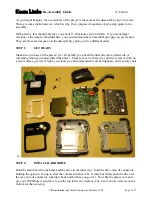
ENGLISH
Troubl
eshooting
Information
HDMI
Control
Function
Pl
ayback
Setup
Connections
Getting Started
Specifications
Numerics
4:3 letterbox
When a wide (16 : 9) disc is played back by connecting a 4 : 3 TV and
the DVD-A1UD, this function plays back the image with black area at
the top and bottom.
4:3 pan-and-scan
When a wide (16 : 9) disc is played back by connecting a 4 : 3 TV and
the DVD-A1UD, this function cuts left and right of the played back
image to the 4 : 3 size according to the disc's control information.
A
Anamorphic lens
This lens enlarges the 16 : 9 image to 2.35 : 1 image when projecting
the image using a projector.
Aspect ratio
This is the length and width ratio of the TV screen. The conventional
TV's screen ratio is 4 : 3 and the wide screen TV's screen ratio is
16 : 9.
B
BD-J (Java)
With BD-Videos, there are fun software with more interactive
functions (games) using Java applications.
BD-LIVE
The DVD-A1UD can be connected to the Internet to enjoy a number
of features, including additional contents such as special videos or
subtitles, network games, etc.
Bit rate
This expresses the read amount per 1 second of video/audio data
recorded in a disc.
Blu-ray disc
This is one-side 1 layer disc having 25GB capacity and can record
high vision video movie and games.
Bonus View
Special images for BD-Videos. It includes comment of the movie
director, simultaneously developing sub-story, and images from
different angles.
C
Chapter
This is a break intended by a producer who organizes the title of BD
or DVD-Video. The chapter search function searches the beginning
of this break.
D
Deep Color
This technology allows expression of more number of colors than the
conventional 8 bits and can reproduce colors close to natural ones
without color streak.
DHCP (Dynamic Host Configuration Protocol)
This mechanism automatically perform network configuration such
as IP address for network devices including DVD-A1UD, PC, and
broadband router.
Dolby Digital (5.1ch Surround)
This is a stereophonic effect developed by Dolby Laboratories. This is
maximum 5.1 channels of independent multi-channel audio system.
Dolby Digital Plus
This is an extension version of Dolby Digital and is a high sound
quality digital audio technology adopted as an optional audio for Blu-
ray disc.
Dolby TrueHD
This lossless coding technology is adopted as optional audio for Blu-
ray disc and supports 7.1 channels.
Downmix
This function converts the number of channels of surround audio to
less number of channels and plays back.
DTS
This is an abbreviation of Digital Theater System, which is a digital
audio system developed by DTS. When playing back audio by
connecting this system with a device such as DTS amplifier, accurate
sound field position and realistic sound effect as if you are in a movie
theater can be obtained.
DTS-HD
This audio technology provides higher sound quality and enhanced
functionality than the conventional DTS and is adopted as an optional
audio for Blu-ray disc. This technology supports multi-channel, high
data transfer speed, high sampling frequency, and lossless audio
playback. Maximum 7.1 channels are supported in Blu-ray disc.
Dynamic range
The difference between the maximum undistorted sound level and
the minimum sound level that is discernible above the noise emitted
by the device.
F
Finalise
This is processing that enables playing back of disc of BD/DVD/CD,
which was recorded using a recorder, by other players.
H
HDCP
When transmitting digital signals between devices, this copyright
protection technology encrypts the signals to prevent content from
being copied without authorization.
HDMI
This is an abbreviation of High-Definition Multimedia Interface, which
is an AV digital interface that can be connected to a TV or amplifier.
Video signal and audio signal can be connected using 1 cable.
I
Interlacing (interlaced scanning)
This conventional method used to project images on a TV displays 1
frame of image in half and half, respectively as 2 fields.
Interactive audio
Audio such as click sound that is generated during operation and is
recorded in the title of BD-Videos.
L
LFE
This is an abbreviation of Low Frequency Effect, which is an output
channel that emphasizes low frequency effect sound. Surround
audio is intensified by outputting 20Hz to 120Hz deep bass.
Linear PCM
This signal is uncompressed PCM (Pulse Code Modulation) signal.
This is the same system as the CD audio but this uses 192kHz, 96kHz,
and 48kHz sampling frequencies in BD or DVD and provides higher
sound quality than CD.
M
MPEG
This is an abbreviation of Moving Picture Experts Group, which is
an international standard of the moving picture audio compression
method. Images of BD and DVD are recorded using this method.
P
Picture-in-picture
This BD-Video function allows you to view making or commentary
scenes in the secondary video while viewing the main story in the
primary video.
Popup menu
This menu recorded in BD software. While playing back a BD,
this menu can be displayed on the front of the screen and can be
operated.
Primary audio
This audio signal is recorded in the main story in BD-Video.
Progressive (sequential scanning)
This is a scanning system of video signal that displays 1 frame of
video as one image. Compared to the interlace system, this system
provides images with less flickering and bleeding.
R
Rating
Depending on the age of the viewer, this function restricts playing back
of BD-Video or DVD-Video. DVD-A1UD can be set to restrict viewing
in 0 to 254 level for BD-Video, and 1 to 8 level for DVD-Video.
Region code
This code indicates country or region where the BD or DVD-Video can
be played back.
S
Secondary audio
This is audio signals of comment of movie director and other data
recorded in the bonus view of BD-Video.
T
Title
This is the unit of content that consists of chapters of BD or DVD
-Video. Some BD or DVD-Video may include multiple titles.
Explanation of Terms
Information
















































